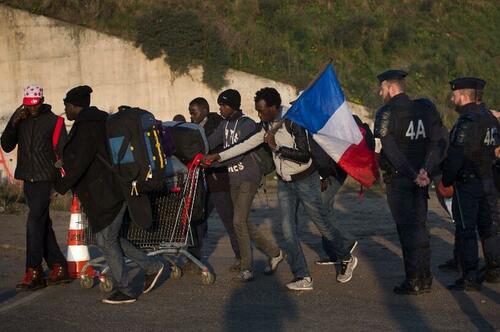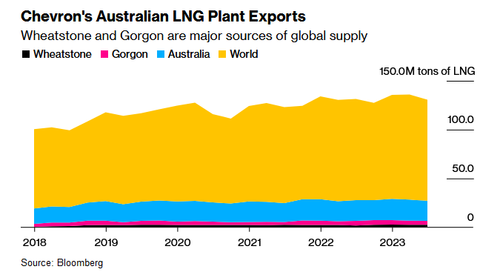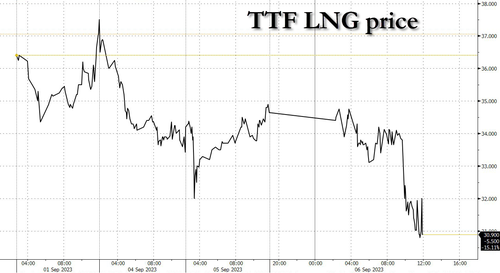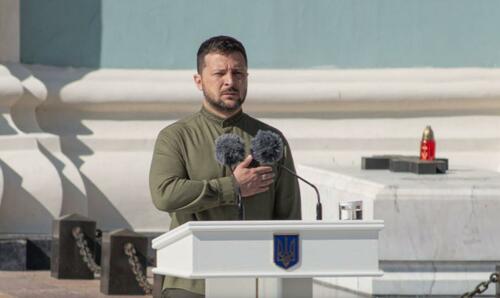Authored by James George Jatras
A version of this presentation was given to the Ron Paul Institute’s Scholars Seminar on Sept. 1st in Washington, DC.
Today it’s hard for anyone under the age of 50 to appreciate how genuine and pervasive was fear of a nuclear holocaust during the Cold War between the US- and Soviet-led blocs.
Books, movies, and TV both reflected and stoked popular anxiety about the possible “end of civilization as we know it.” The heyday for this was in the 1950s and 1960s, with books like The Long Tomorrow(1955) and On the Beach (1957, with a 1959 film adaptation), and films like Fail Safe, Seven Days in May, Dr. Strangelove (all in 1964, while the real-life scare of the 1962 Cuban Missile Crisis was fresh in people’s minds).
There appeared to be a bit of a lull during the 1970s era of US-Soviet détente under Nixon, Ford, and Carter, perhaps also reflecting elite sympathy for socialism and an expected future convergence between the ideological groupings, which on a basic level shared the same globalist, materialist values. But nuclear terror returned with a vengeance in the 1980s – for example, The Day After (1983) and the animated When the Wind Blows (1986). And who can forget (certainly no male person!) the delightful Nena’s 1983 music video Neunundneunzig Luftballons.

The Left, both in the United States and worldwide, was unanimous that Ronald Reagan, a self-confessed anti-communist, was a reckless cowboy who wanted to blow up the planet. As that great philosopher, Sting, put it in his 1985 song, “The Russians”:
There is no historical precedent
To put the words in the mouth of the president?
There’s no such thing as a winnable war
It’s a lie we don’t believe anymore
Mister Reagan says, “We will protect you”
I don’t subscribe to this point of view
Believe me when I say to you
I hope the Russians love their children too
The irony is that Reagan’s own views were hardly different from the ones the song sought to promote. As he stated jointly with Soviet premier Mikhail Gorbachev that very same year, 1985: “A nuclear war cannot be won and must never be fought,” a view that prevailed until the USSR imploded just a few years later.
We live in a very different world now, where the prospect of nuclear annihilation barely registers with anyone.
Just as big earthquakes are often preceded by foreshocks, major wars are frequently heralded by smaller conflicts. Before World War One: the Franco-German Morocco crises (1906 and 1911), the Italo-Turkish War (1911-12), the two Balkan Wars (1912, 1913). Before World War Two: the Second Italo-Ethiopian War (1935-37) and, the most famous pre-conflagration rumble of them all, the Spanish Civil War (1936-39).
Today, we are looking at a possible regional war in West Africa, centering on American and French demands that “democracy” be restored in Niger. (As one Indian publication put it, “Death follows Victoria Nuland”) Then, of course, there’s China/Taiwan.
But the obvious Spanish Civil War-rank conflict of the moment is Ukraine.
I don’t think we need to go into all the details of how we got here, but just in brief:
- Relentless NATO expansion after 1991;
- The 2014 US- and EU-backed coup that overthrew Victor Yanukovich, followed by the Russian annexation of Crimea and the new Kiev regime’s launch of a war to repress rebellions in the Russian-speaking east and south of the country;
- The 2015 Minsk agreements, which provided for Ukraine’s neutrality and decentralization, and for reintegration of the rebellious areas with protections of their language and culture – agreements that both Ukrainian and European former officials have admitted they never intended to implement, seeing them only as a delaying ruse for building up a force capable of conquering the Donbas;
- A relentless program of Ukraine’s NATO-ization in all but name under Obama, Trump, and Biden; and
- Washington’s peremptory rejection of Moscow’s 2021 ultimata to the United States and NATO to resolve the conflict diplomatically, with the hope that Russia, baited into an incursion into Ukraine, would be bled white in an Afghanistan-style insurgency and by crushing sanctions that would “turn the ruble into rubble,” pancake Russia’s economy, and lead to regime change in Moscow.
Oops. Russia’s expected ruin didn’t happen. Even the mainstream media cheerleaders of only a fortnight ago now admit that Ukraine is losing, assigning the blame not to the geniuses that thought up this strategy (if it can be called that) but to Ukraine’s being too “casualty averse” – even as that country is turning into one vast graveyard. There’s speculation that some in Washington and other western capitals are seeking an “off-ramp” – if for no other reason than the need to focus on the really big show, a looming war with China. Some suggest that in the end, we’ll just walk away, consigning Ukraine to the Memory Hole along with Afghanistan. All that’s left then is for GOP neocons to whine that the Biden Administration was too stingy with their aid and “lost Ukraine” while they gear up for the main event in the western Pacific.
Personally, I don’t think that will happen. Nobody cares about Afghanistan but the Afghans, but if Washington walks away from Ukraine it’s effectively conceding that the US, through NATO, no longer is the security hegemon of Europe. That means the effective end of NATO, in fact if not in name; and where NATO goes, its concubine, the European Union, won’t be far behind.
More to the point, though, the notion that this will soon end with a whimper misses the whole point. None of this is really about Ukraine, which is just an expendable tool to hurt Russia. (Maybe the Poles or Lithuanians or Romanians are eager to volunteer for the job once we’re fresh out of Ukrainians.) Ukraine is just a variable; the constant is Ruthenia delenda est. Russia must be destroyed.
Gilbert Doctorow, a noted observer of Russian affairs, likens the current situation to that of Napoleon’s 1812 Russian campaign depicted by Leo Tolstoy in War and Peace. Today as then, what happens next will be less due to this or that policymaker making this or that bad decision. Rather, “the precondition for war is the near universal acceptance of the logic of the coming war.”
What is that logic today? It’s simple: the ruling circles in the United States (needless to add, with their sock puppets in western capitals) are utterly, unselfconsciously convinced that they are the living embodiment of all virtue, truth, and progress in what Russian Foreign Minister Sergei Lavrov described as the “replication of the experience of Bolshevism and Trotskyism” – to cite Reagan, morphing ourselves into a new Evil Empire in place of the old one. As neocon kingpins William Kristol and Robert Kagan put it in their 1996 manifesto, the policy of the United States in the coming era must be one of “benevolent global hegemony” intended to last – well, forever. Its moral content is exemplified, on the one hand, by US support for subjugation of the canonical Ukrainian Orthodox Church and, on the other, the spectacle of a transgender US serviceperson acting as a PR official for the Ukrainian military declaring that “we’re human,” and the Russians “most definitely aren’t.”
As I like to say: there’s no Transatlanticism without transgenderism.
Unsurprisingly, regarding their alleged lack of human-ness, the Russians disagree. But who cares what they think? Our leaders see not only Putin but Russians in general as an obstacle to the radiant future, where every knee will bow before the sacred rainbow flag.
Sun Tzu says “If you know the enemy and know yourself, you need not fear the result of a hundred battles. If you know neither the enemy nor yourself, you will succumb in every battle.” The Russians more or less know themselves. They kind of know us, but not as well as they think they do, with rather a tendency to project normalcy onto fundamentally abnormal people. On the other hand, our rulers – dangerous people whose levels of arrogance and ignorance defies description: monkeys with nuclear hand grenades – know neither themselves nor the Russians.
On top of that, as Doctorow further observes, the mechanisms that lent some stability and restraint to the US-Soviet standoff are now all but gone, rendering the once-“unthinkable” of the 1950s’ nuke horror films all-too-thinkable today:
‘… no one wants war, neither Washington nor Moscow. However, the step-by-step dismantling of the channels of communication, of the symbolic projects for cooperation across a wide array of domains, and now dismantling of all the arms limitation agreements that took decades to negotiate and ratify, plus the incoming new weapons systems that leave both sides with under 10 minutes to decide how to respond to alarms of incoming missiles—all of this prepares the way for the Accident to end all Accidents. Such false alarms occurred in the Cold War but some slight measure of mutual trust prompted restraint. That is all gone now and if something goes awry, we are all dead ducks.’
“No one wants war.” A similar thought was expressed by Hermann Göring, when he was on trial at Nuremberg:
Of course the people don’t want war; neither in Russia nor in England nor in America, nor for that matter in Germany. That is understood. … But after all, it’s the leaders of the country who determine the policy, and it’s always a simple matter to drag the people along whether it’s a democracy, a fascist dictatorship, or a parliament, or a communist dictatorship. Voice or no voice, the people can always be brought to the bidding of the leaders. That is easy. All you have to do is tell them they are being attacked, and denounce the pacifists for lack of patriotism, and exposing the country to greater danger.
So I guess Doctorow is a bit off the mark in suggesting that “no one wants war.” Clearly, somebody wants war. A lot of very important “somebodies” wanted this war in Ukraine. They wanted war in the Balkans in the 1990s. They wanted war in Afghanistan, Iraq (twice!), Libya, Yemen, Syria, and a dozen places in Africa where we have almost no idea what’s going on.
“All you have to do is tell them they are being attacked…” I can’t help but think of the meme with two blank-face NPCs, one wearing a pink knit hat mindlessly repeating “Russia! Russia! Russia!,” the other with a red MAGA hat chanting “China! China! China!” Between them is the seal of the CIA with the eagle saying, “Yes, yes, my pretties. That’s it. That’s it.”
Here we are, 60 years after the fact, with the growing recognition by even the most spoon-fed normies that the CIA had something to do with the assassination of Jack Kennedy. In fact, we have here today perhaps the foremost authority on the topic, Mr. Jacob Hornberger. Yet doubting our rulers’ truthiness still is treated as a thought crime. A little while ago, Vivek Ramaswamy was the target of a media hate fest for (in the words of The New Republic) “spout[ing] conspiracy theories about January 6 and 9/11.” Oh no! “Conspiracy theories”! (Or, as they are known when they turn out to be true, “spoiler alerts.”) The heretic Ramaswamy evidently believes – shocking as this sounds – that our government has not been entirely honest about these matters. He must be a dupe for the Russians! Or for the Chinese! – which The New Republic also implies.
You may have heard some people compare the “lawfare” being directed against Donald Trump, with the evident aim of eliminating the likely opponent next year of the desiccated-husk-of-Hunter-Biden’s-dad (assuming ol’ Joe will be the Democratic nominee, which I don’t), to the behavior of a banana republic. This is a gratuitous insult to the friendly spider-infested nations to our south!
I recently suggested to a sober observer of public affairs that the strategic goal is keeping Trump off the ballot in one or more must-win states for him, like Pennsylvania, Michigan, Georgia, Arizona, to which he responded: “That’s a recipe for civil war.” (I tried to imagine what Republicans taking to the streets would look like. A mob of decrepit Boomers rolling their motorized wheelchairs down to the corner and burning down the post office?) Anyway, taking him out via lawfare seems to be Plan A. If that fails – well, Plan B would get us into Mr. Hornberger’s area of expertise.
The term “cold” civil war, a war that might possibly turn “hot,” has become a commonplace in American discourse. So has the expression “national divorce.” In 1861 Americans both North and South worshipped the same God, read the same Bible, honored the same Founding Fathers, claimed fidelity to the same Constitution. In today’s America, we can’t even agree on our pronouns or on what a “woman” is, much less on what it means to be an American. We are moral aliens to one another, indeed enemies. What actually holds the former American republic together? “Muh Constitution”? “Muh democracy”?
Keep in mind, we’re not talking about a mere political crisis that will get solved in an election or two. Not even about political and constitutional collapse, or even a financial and economic calamity – that’s coming too, in part because of the impact of the Ukraine war on the dollar-denominated global system – but a fundamental challenge to the social fabric itself, and not just in the United States.
A watershed was passed with covid and the measures – the lockdowns, the masks, social distancing and monitoring, the clot shot, censorship of dissent, all combined with a pervasive, inescapable external and internal panopticon: as the troubadour of transhumanism Yuval Harari writes, “we are seeing a change in the nature of surveillance from over the skin surveillance to under the skin surveillance” – supposedly intended to deal with a virus, accomplishing within a few short months what decades of climate hysteria could not, summed up under the moniker “the Great Reset” and its ubiquitous slogan “Build Back Better.”’
Taken together what we’re experiencing has all the appearance of a controlled demolition of all established human interactions in anticipation of their replacement by something we are assured by our betters will be an improvement. The contours of the “new normal” in the post-American America hurtling in our direction have already become so familiar as to need little elaboration:
- Infringement of traditional liberties based on “keeping us safe”;
- “Cancel culture”;
- Blurring of the lines between Big Government, Big Finance, Big Pharma, Big Data, etc., amounting to corporate state capture; and, not directly based on supposed anti-virus measures but closely tracking with them,
- Joint government and corporate promulgation of socially destructive, historically counterfeit ideologies (“intersectionality,” LGBTQI+++, feminism, multiculturalism, “critical race theory,”), with principal targeting of children subject to sexualization and predation by those expressing what were once quaintly known as abnormal appetites and identities.
These so-called “values” – which, remember, are effectively the official ideology of the West, which we seek “benevolently” to impose on the rest of the world, by force if necessary – in turn accelerate longstanding trends towards infertility and demographic collapse pointing to thinning the human herd and replacement via post-human society, transhumanism, and bio-engineering. This is not just “political” but a strike at the heart of human existence: the spiritual, moral, and even biological basis for marriage, family formation, and production of the next generation. In a word: depopulation.
A few years ago, His Royal Highness, the late Prince Philip of the United Kingdom, perhaps half in jest delivered this thigh-slapper: “In the event that I am reincarnated, I would like to return as a deadly virus, to contribute something to solving overpopulation.” Some of you may have heard of groups like Extinction Rebellion and BirthStrike: “Are you terrified about the future that lies ahead for contemporary and future youth? Do you want to maximize your positive impact on the Climate Change Crisis? You can protect children while fighting climate change and systematic corruption by refusing to procreate!” Makes perfect sense: preserve a better planet for future generations by eliminating future generations. It reminds me of Otto von Bismarck’s comparing the idea of preventive war to committing suicide out of fear of death. (That’s not as abstract as it might sound. Recently a young woman in Canada seeking help for depression and suicidal ideation was advised by hospital staff that she might be interested in their tried and Trudeau-ed “Medical Assistance in Dying (MAID)” euthanasia program. Tempted to kill yourself? Let us help you!)
But why stop at half measures? The Voluntary Human Extinction Movement, VHEMT (pronounced “vehement,” according to their website): “We’re the only species evolved enough to consciously go extinct for the good of all life, or which needs to. Success would be humanity’s crowning achievement. May we live long and die out.”
Maybe they’re on to something! In his landmark work The Socialist Phenomenon, the late Russian mathematician and student of history Igor Shafarevich took note of what he believed is a collective human death impulse:
The idea of the death of mankind—not the death of specific people but literally the end of the human race—evokes a response in the human psyche. It arouses and attracts people, albeit with differing intensity in different epochs and in different individuals. The scope of influence of this idea causes us to suppose that every individual is affected by it to a greater or lesser degree and that it is a universal trait of the human psyche.
This idea is not only manifested in the individual experience of a great number of specific persons, but is also capable of uniting people (in contrast to delirium, for example) i.e., it is a social force. The impulse toward self-destruction may be regarded as an element in the psyche of mankind as a whole. [ … ]
In the Freudian view (first expressed in the article “Beyond the Pleasure Principle”), the human psyche can be reduced to a manifestation of two main instincts: the life instinct or Eros and the death instinct or Thanatos (or the Nirvana principle). Both are general biological categories, fundamental properties of living things in general. The death instinct is a manifestation of general “inertia” or a tendency of organic life to return to a more elementary state from which it had been aroused by an external disturbing force. [“Dust thou art, unto dust shalt thou return.”] The role of the life instinct is essentially to prevent a living organism from returning to the inorganic state by any path other than that which is immanent in it.
Marcuse [Shafarevich refers here to Herbert Marcuse, theorist of the Frankfurt School, known for his adaptation of the theory of class conflict in classical Marxism to other social divides, notably in the area of sex, setting the stage for “intersectionality”] introduces a greater social factor into this scheme, asserting that the death instinct expresses itself in the desire to be liberated from tension, as an attempt to rid oneself of the suffering and discontent which are specifically engendered by social factors.
With the failure of the Ukrainian offensive, Moscow now faces a dilemma. Do they move decisively to impose a military solution that ends the war, or do they continue to show restraint in the hopes that somebody, somewhere – Kiev, Washington, London, Brussels – decides it’s time to sue for peace? Keen not to take a precipitous step that might bring about a direct clash of NATO and Russian forces, so far they’ve opted for the latter – I repeat: so far.
The West faces its own dilemma. Do our rulers concede defeat, which effectively means the end of the Global American Empire (the GAE)? Or do they drag things out as long as possible, hoping Moscow will fall for another Minsk-type ceasefire, with the Kremlin playing the part of Charlie Brown taking another run at kicking the football, having been promised that this time we’ll keep our word? Or, mistaking Russian restraint for weakness, do they push the envelope by inserting a “coalition of the willing” into western Ukraine, challenging Russian naval forces in the Black Sea, encouraging and equipping the Ukrainians to step up attacks on Moscow and other Russian cities, staging some sort of false flag of the type that has proved so effective in other conflicts? In other words, do we double down? That’s in addition to opening up other asymmetrical theaters in the Balkans, Syria, Iran, the Taiwan Strait, and elsewhere.
In mistakenly projecting a rational actor mentality onto their opponents, the Russians seem to be acutely aware of the legitimate concern that decisive military action on the ground could panic NATO and trigger an uncontrolled escalation. They seem oblivious to the contrary concern, that, by holding back and waiting for a reasonable dialogue that will never take place, they are in effect encouraging their adversary to stage one reckless provocation after another – in the sustained belief that some deus ex machina can snatch victory from the jaws of defeat – resulting in the very uncontrolled escalation that Moscow seeks to avoid.
Even these speculations assume that the miserable specimens of humanity calling the shots in Western capitals would only risk a direct conflict but would not deliberately choose it. But is that assumption correct? As Doctorow notes, the old Cold War restraints have broken down. Maybe demonstration of a teeny-tiny, low-yield nuke is just the thing to show that non-human Vladof Putler that the GAE is serious!
What could possibly go wrong?
Recently on his podcast Judge Andrew Napolitano showed part of a computer simulation of a US-Russia nuclear exchange in which the initial toll on the US population was only (“only”!) about nine percent, while on Russia it was around 62 percent. (Given that Russia has more warheads than we do, I don’t know how they came up with that, but I didn’t conduct the simulation.) Is it so impossible that somewhere, somebody might look at those data and decide it’s a tolerable tradeoff? (Later on, the simulation has pretty much everyone on earth starving to death from nuclear winter, with agriculture in the northern hemisphere unviable for several years. Now there’s a way to resolve both global warming and supposed overpopulation with one stroke! Hey, VHEMT, have we got a concept for you!)
Whether or not these dolts manage to kill us all, either by deliberate action or through sheer incompetence, it’s hard to escape the notion that we are approaching the edge of some profound historical moment that will have far-reaching, literally life and death consequences, both domestically and internationally. In the period preceding World War I how many Europeans suspected that their lives would soon be forever changed—and, for millions of them, ended? Who in the years, say, 1910 to 1913, could have imagined that the decades of peace, progress, and civilization in which they had grown up, and which seemingly would continue indefinitely, instead would soon descend into a horror of industrial-scale slaughter, revolution, and brutal ideologies?
Which brings us to my parting admonitions to your predecessors in this seminar, which I see no need to change:
My young friends, the impact any one of us can expect to have in the face of world-historic trends before which the fates of nations and empires fly like leaves in the autumn winds is vanishingly small. Already baked into the cake will be, I believe, hardships for you that we’ve become accustomed to think only happen to “other people” in “other countries” far away, not seen here since the Revolution and the Civil War, or maybe in isolated instances during the Great Depression: financial and economic disruption and, in some places, especially in urban areas, collapse; supply chains, utilities, and other aspects of basic infrastructure ceasing to function (what happens in major cities when food deliveries stop for a week?), even widespread hunger; rising levels of violence, both criminality and civil strife. These will be combined, paradoxically, with the remaining organs of authority, however discredited, desperately cracking down on the enemy within – no, not on murderers, robbers, and rapists, but on “science deniers,” “religious fanatics,” “haters,” “conspiracy theorists,” “insurrectionists,” “gun nuts,” “purveyors of “medical misinformation,” Russian or Chinese “stooges,” and, of course, “racists,” “sexists,” “homophobes,” and so forth. It’s the late Samuel Francis’ “anarcho-tyranny” nightmare come to life with a vengeance.
Nevertheless, for what it is worth, I put before you three practical tasks for your consideration.
Firstly, be vigilant against deception, in a day when assuredly evil men and impostors will grow worse and worse, deceiving, and being deceived. Admittedly, this is a tough one, given the ever-present lying that surrounds us and the suppression of dissent. Try to sift truth from falsehood but don’t become obsessed because, in many cases, you won’t be able to be sure anyway. Focus most on what’s proximate to you and on the people most important to you. … Be skeptical – about everyone. … There may be a cost. As Solzhenitsyn said, “He who chooses the lie as his principle inevitably chooses violence as his method.”
Secondly, as stewards of every worldly charge placed on us by God and by other people—as fathers and mothers, as husbands and wives, as sons and daughters, as neighbors, as students, as workers, as citizens, as patriots—we must prudently care for those to whom we have a duty within the limited power and wisdom allotted to us. Start with yourselves. Be as self-sufficient as possible. Get involved in your community; that leftist slogan is actually a good one: think globally, act locally. Befriend your neighbors. Learn a real skill – electricity, plumbing, carpentry. Farm! Don’t go to law school, for goodness’ sake. Get in shape. Eat and sleep right. Have plenty of the essentials: food, fuel, gold, ammunition. Learn to shoot. Limit computer and phone time. Experience nature. Cultivate healthy personal relationships – real ones, not virtual ones. Marry young, have kids, lots of them – especially women, don’t get seduced by all that “career” nonsense. Nobody on his or her deathbed ever said, “Gosh, I wish I’d spent more time at the office.” Read old books. Cultivate virtue. Go to church.
Simply being what used to be considered normal and leading a productive life is becoming the most revolutionary act one can perform. With that in mind, find the strength to be revolutionaries indeed! In the face of the culture of death and extinction, choose to affirm life.
You’ve seen the meme: Hard times create strong men; Strong men create good times; Good times create weak men; Weak men create hard times. Well, take it from the weakling Boomer generation that brought them to you: the hard times, they is a-coming. But they won’t last forever. If you live through them – and some of you will not – we’ll see what possibilities, as of now literally unimaginable, might then exist. But you will need to be personally fit to take advantage of them. You will also need to be part of some kind of sustainable community of likeminded people.
Thirdly, for those of you who are believers, particularly Christians, we must pray without ceasing, firm in faith that, through whatever hardships may lie ahead, even the very hairs of our head are all numbered, and the final triumph of Truth is never in doubt.
Thank you, and good luck. You’re going to need it.







 Opinion dégradée des Français sur les immigrés
Opinion dégradée des Français sur les immigrés




